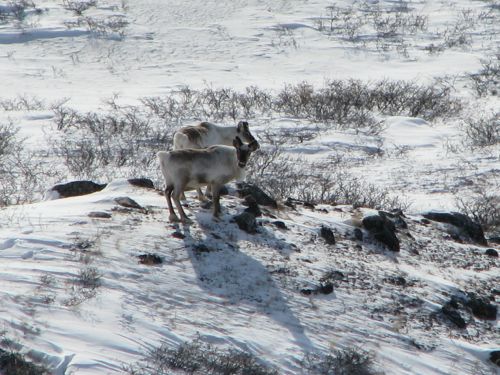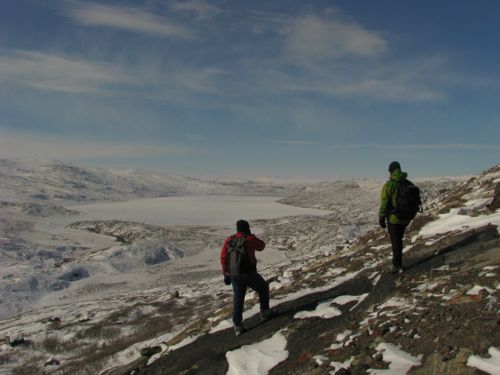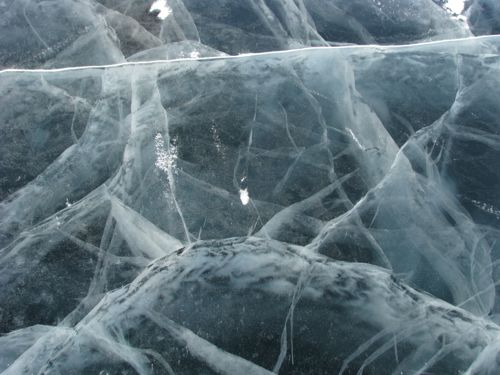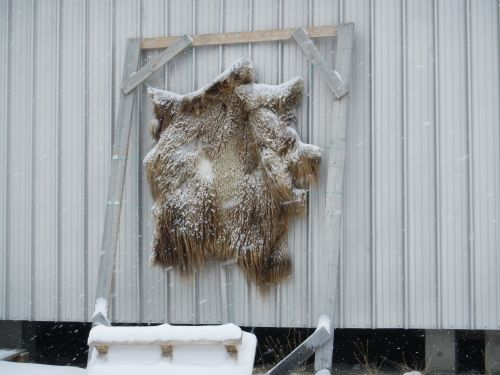Yet Another Weather Day
Yesterday's storm has largely blown itself out, but there remains behind sufficient cloudiness in our target areas to keep us grounded. To get an idea of what yesterday was like here is a short clip I took from the porch of the KISS building (I didn't really want to venture much further).
http://youtu.be/JDaGKkuf7rw
Some colleagues and I took the opportunity to go for a long hike. We chose as a target the so-called Garnet Mine: not really a mine, but a mountain whose rock contains many garnet crystals. It is a favorite destination for OIB team members, but most usually make the hike when the ground is free of snow.
Yesterday's new snow made our hike all the more difficult, and while the weather was cold, trudging through snow warmed us nicely. It also tired us out. On the way to the "mine" we saw three caribou and two musk ox. I didn't get any good photos of the musk ox as they were too far off, but the caribou showed less fear.
 A couple of caribou warily eye us. They would soon hightail it in the other direction.
A couple of caribou warily eye us. They would soon hightail it in the other direction.
 A view from near the Garnet Mine. We are walking on the south side of the ridge to avoid the snow you see in the background. Despite persistent temperatures below freezing, the dark ground absorbs enough radiation to melt the thin layer of snow, but only on south aspects.
A view from near the Garnet Mine. We are walking on the south side of the ridge to avoid the snow you see in the background. Despite persistent temperatures below freezing, the dark ground absorbs enough radiation to melt the thin layer of snow, but only on south aspects.
The ice on the myriad lakes and tarns in this part of Greenland seems to be about two feet thick right now. You can tell because the clarity often allows you to see down that far. The cracks in the ice make for dramatic patterns.
 The patterns in the ice here are mesmerizing. Most lakes are fairly bare of snow due to the stiff winds that commonly blow through.
The patterns in the ice here are mesmerizing. Most lakes are fairly bare of snow due to the stiff winds that commonly blow through.
Kanger Culture
You see this all over town:
 A musk ox hide dries outside. These and caribou hides adorn the sides of many residences around town.
A musk ox hide dries outside. These and caribou hides adorn the sides of many residences around town.
People tanning the hides of a muskox. Often the people doing this are not the actual hunters. The hunters will often sell the hides to someone who will spin the hair into wool and then make and sell clothing made from muskox fur. Quiviut, as we call it in Alaska, makes for a soft, warm garment, but its relative scarcity commands a premium. Like a $100 hat, for instance.
 Yum! How about a salad with that?
Yum! How about a salad with that?
This is one of the local lunch staples: French fries with sausage (i.e. a heart attack bomb). I haven't had it yet (and I'm not sure I will). The two restaurants in town don't serve a single vegetable dish, like a salad. Some entrees have vegetables in them, but not many do, and the veggies are pretty sparse in those that do.
Finally...
Here is a video NASA recently produced detailing the ice elevation throughout Greenland. I thought they did a fantastic job with this one. You can bet the video is based upon OIB data.
http://
Today was the day of my PolarConnect event. And since I'm writing this one day later (as I usually do) I can say that I had a lot of fun with it. Thank you to Mr. Harder and Mr. Fenster for making things on the EHS end work. I really appreciate it. And thanks to all of my students for asking such interesting questions. Obviously most of them were over my head - good thing I had a couple of NASA experts flanking me.


Comments